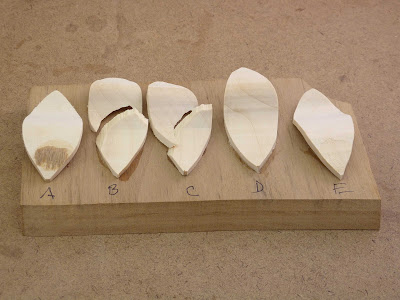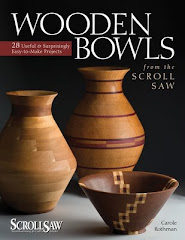Thursday, June 9, 2016
When clamping's not an option--the video
Many of my projects cannot be glued using standard clamps. Instead, I use hand pressure and the right adhesive. Here's a video of my tests, to supplement my previous post.
Wednesday, June 1, 2016
When clamping is not an option
I often find myself in situations where I need a strong glue joint but clamping is out of the question. It might involve attaching a bow loop to a box lid, gluing a strip on the diagonal, or joining two pieces of thin wood.
My solution has been to use my hands to apply clamping pressure, along with an adhesive with a quick grab and relatively fast set-up time. As my projects increased in complexity, I found that Weldbond, my go-to PVA glue, was too slow-setting to be practical for my new needs. I was reluctant to use a CA glue, since they are vulnerable to shear, and no one wants to see decorations snap off with normal handling.
When a new product, Nexabond, came on the market, it was touted as a CA glue formulated for use with wood. I gave it a try, and it performed as well as Weldbond, but with a much faster set-up time. It soon became my adhesive of choice for these special gluing situations.
However, when it became unavailable, I needed to find a suitable replacement. I located several contenders and set up a test to see how they stacked up against each other, and against Weldbond. The three on the left are CA adhesives, and the two on the right are PVA glues.
I tested them for ease of application, for how long it took for a piece to hold its position when pressure was released, and for resistance to shear. The results were quite encouraging. All adhesives performed well when subjected to "normal" rough handling, such as picking up a lid by the center loop or tail. When I tried to separate the pieces from the wood, to see if they would shear at the glue line, there was some variation.
The best CA performers overall were Titebond Thick and DAP RapidFuse. (RapidFuse is actually Nexabond Medium, renamed, and now manufactured by DAP.) The Titebond Gel formula was too thick to spread easily, but performed best for tests were it could be "blobbed" on.
The two PVA glues performed well as far as ease of application and resistance to shear. Titebond Quick&Thick had slight edge in resistance to shear, but is less versatile than Weldbond as a general adhesive, making it more of a specialty product.
On a test that involved the insertion of multiple pieces of veneer between two pieces of wood, neither PVA glue produced satisfactory results. Tasks like this need the faster set-up time of the CA adhesives, and the thick and medium formulations were easier to spread than the gel.
Your choice depends, of course, on your specific needs, but you can be confident that these are all quality products that deliver what they promise.
My solution has been to use my hands to apply clamping pressure, along with an adhesive with a quick grab and relatively fast set-up time. As my projects increased in complexity, I found that Weldbond, my go-to PVA glue, was too slow-setting to be practical for my new needs. I was reluctant to use a CA glue, since they are vulnerable to shear, and no one wants to see decorations snap off with normal handling.
When a new product, Nexabond, came on the market, it was touted as a CA glue formulated for use with wood. I gave it a try, and it performed as well as Weldbond, but with a much faster set-up time. It soon became my adhesive of choice for these special gluing situations.
However, when it became unavailable, I needed to find a suitable replacement. I located several contenders and set up a test to see how they stacked up against each other, and against Weldbond. The three on the left are CA adhesives, and the two on the right are PVA glues.
I tested them for ease of application, for how long it took for a piece to hold its position when pressure was released, and for resistance to shear. The results were quite encouraging. All adhesives performed well when subjected to "normal" rough handling, such as picking up a lid by the center loop or tail. When I tried to separate the pieces from the wood, to see if they would shear at the glue line, there was some variation.
The best CA performers overall were Titebond Thick and DAP RapidFuse. (RapidFuse is actually Nexabond Medium, renamed, and now manufactured by DAP.) The Titebond Gel formula was too thick to spread easily, but performed best for tests were it could be "blobbed" on.
The two PVA glues performed well as far as ease of application and resistance to shear. Titebond Quick&Thick had slight edge in resistance to shear, but is less versatile than Weldbond as a general adhesive, making it more of a specialty product.
On a test that involved the insertion of multiple pieces of veneer between two pieces of wood, neither PVA glue produced satisfactory results. Tasks like this need the faster set-up time of the CA adhesives, and the thick and medium formulations were easier to spread than the gel.
Your choice depends, of course, on your specific needs, but you can be confident that these are all quality products that deliver what they promise.
Subscribe to:
Comments (Atom)






